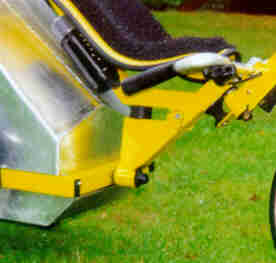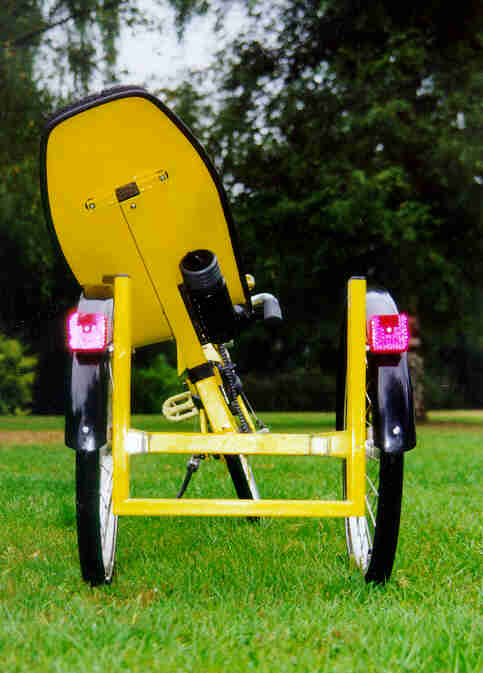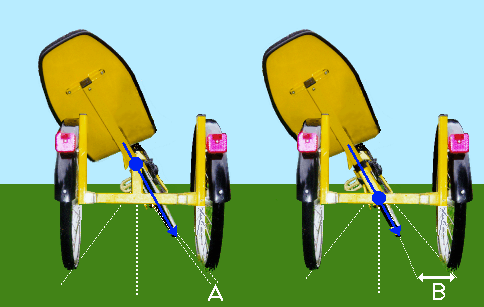Variation number 6: improved tilting mechanism on the trike back-piece.
|

|

|
The standard trike back-piece has a ball-and-socket joint (called DuSchar-joint) that has a double function.
It hinges vertically to to make springing possible, and it can tilt, too, to make tilting of the front part possible,
while the back part stays upright.
This tilting has some big advantages:
- When you ride a corner at a moderate speed, you can lean into turns to prevent rollover;
- When you ride off a pavement diagonally, you won't be shaken from the left to the right;
- A bump under one rear wheel will only half be conducted to the driver, because the difference in height is halved by the other wheel.
But some marginal notes have to be made to this tilting system:
The rear part (the luggage trunk) doesn't tilt and isn't sprung. That means:
- That the rear wheels have to endure a heavy side load in turns;
- The luggage in the trunk shakes and rattles (watch out when you transport 500 eggs!);
- In a turn, the trunk won't tilt, giving it a tendency to tilt to the outside of the corner - especially with heavy loads in it.
That last issue once made me fall painfully:
I was riding my trike with a 50 kg. bag of wheat, and turned to the right. The centrifugal effect pulled the luggage to the left.
But my own weight pushed the rear part to the left, too, by means of the high placed tilt-joint.
Together, these forces were big enough to rollover the rear part.
And because that part was not allowed to turn freely around the length-axis,
it rolled me over, too. That was my first and last forced air trip.
This made me think. How to prevent this?
- Of course, you could broaden the rear part substantially.
But I just wanted a narrow trunk to be able to slalom easily between poles,
to be able to ride besides of another bike, etc.
- The centre of gravity of the trunk could be lowered.
I did it by taking away the axle and the frame-tube out of the box, so that bigger loads
can be placed lower.
- The point of application of the tilting mechanism can be lowered.
I did the lowering of the point of application of the tilting mechanism by splitting apart the double function of the original joint:

On the detailed picture as shown on the right, you can see how it is done.
The spring part works the same way as in a standard bike;
while the tilting mechanism is placed much lower (about 17 cm. above the ground).
It is made of the same type of axle that is used in the steering mechanism.
 From the rear it shows like this:
From the rear it shows like this:
In the picture below, the advantage is illustrated:
The left picture depicts a standard Flevo-trike. The tilting point (blue dot) is placed pretty high.
In the right situation, the lowered tilting point is used.
The result of this is, that in the same degree of tilting,
the resulting force as a result of the driver's weight (blue arrow) is projected much more
to the middle between both rear wheels (distance 'B' is much bigger than 'A').
In an ideal situation, the tilting point should be at the ground:
In that case, the blue arrow will always be projected in the middle between both wheels.
(Actually, that is the situation as in the bike! Driving it, you could not feel the difference between this trike and a bike.)






 From the rear it shows like this:
From the rear it shows like this:

